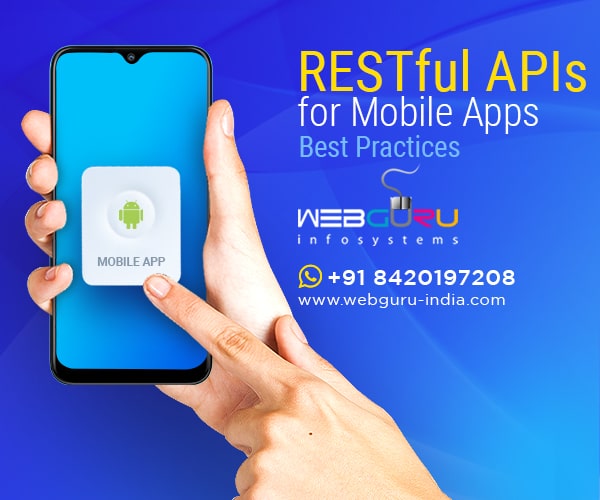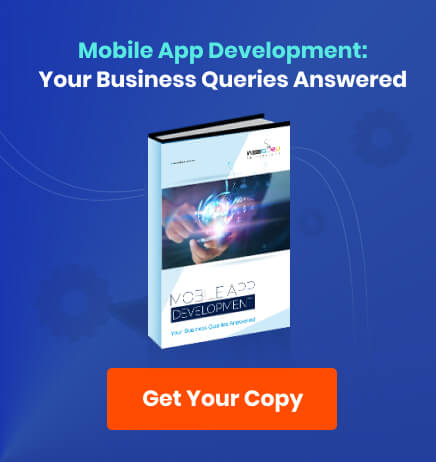Home Blog Mobile App Development Best Practices To Build RESTful APIs For Mobile Apps
Best Practices To Build RESTful APIs For Mobile Apps
- 21 Feb / 2020
- 11,210 views

The popularity of mobile apps has truly brought the benefits of the digital revolution to everyone. If figures are to be believed then mobile apps are going to touch an expected revenue of $188.9 billion globally in 2020. The appetite of users for such apps across industry verticals has made the job of developers a challenging one. This is due to the fact that developers of any mobile app development agency have to come up with attractive designs, seamless navigation, and robust security features to make the app trendy and acceptable to the target audience. Lately, the focus is on using Agile to improve the quality of mobile app development. One of the factors determining the smooth functioning of a mobile app is its quality of connection to the server. This is where the APIs come into play. Let us understand what APIs are all about.
API and its benefits
An API or Application Programming Interface is a communication protocol that allows an application to access the data, features, service, or operating system. It is also a tool used by developers to create a mobile application and deliver functions quickly. For example, it is the API that detects an interaction when you touch the screen of your smartphone. In other words, an API lets two distinct web services on the internet to communicate and exchange information with each other. As an intermediary between two services, the API comes in four major forms viz., Open APIs, Partner APIs, Internal APIs, and Composite APIs.
We all use APIs in one form or the other. For example, while clicking pictures on a smartphone, we use the camera’s API. Also, when an app asks for your location, it uses the geolocation API in your browser. Importantly, APIs can control access to your system’s software or hardware and has a role in offering security as well.
Since APIs practically control the functioning of an application, it should be robust (and lightweight) enough to make the exchange of information, seamless, streamlined, secure, and fast. In other words, developers at any app development agency in India or elsewhere ought to use an API that fulfils the above-mentioned criteria. This is where a RESTful API comes into the picture.
What is a RESTful API?
It is a set of functions that developers use to send requests or receive responses through an HTTP protocol. Based on the Representational State Transfer (REST) protocol, RESTful APIs offer seamless interoperability among computer systems on the World Wide Web. A RESTful API uses the HTTP protocol to create, update, or delete data. It enables an application to be easily modified and become scalable.
How RESTful API for a mobile app is different?
- Since mobile app users can be very demanding, developers should use RESTful APIs to avoid server issues. In other words, the API ensures users do little while the servers do the most.
- For mobile apps, the RESTful APIs use the HTTPS protocol, which is more secure for using a Secure Socket Layer (SSL).
- Since mobile apps undergo a lot of updates they should have a robust process for version control to manage the changes better.
- The APIs for mobile apps should ensure all functionalities accessed by the user, while being offline, to be reconciled when going online.
How RESTful APIs function?
A sequence of information to be exchanged on the network is broken down into a series of modules giving developers a lot of flexibility. The RESTful APIs take advantage of HTML as laid down by the RFC 2616 protocol. They use PUT to update or change the status of a resource, POST to create and GET to retrieve the resource.
Thus, RESTful APIs will turn your mobile app simple, portable, scalable, reliable, and modifiable. As a company offering mobile app development services in India, you can get APIs from third parties or leverage the ones offered by Facebook, LinkedIn, Google, or Amazon. However, should you want to build an API in-house there can be speed bumps. So, it is advisable to follow the best practices, be it in designing, developing, testing, or managing.
Building a RESTful API for a mobile app
The tips to build a RESTful API for a mobile app include aspects such as choosing a database, ensuring security, hosting the server, building a back-end architecture, complying with various protocols, and supporting multiple platforms.
Server hosting: Choosing the right server is of prime concern as ultimately the app will fetch information from there. You can choose from plenty of cloud-based servers to get performance and scalability. The factors you ought to keep in mind while evaluating the efficacy of a server include
- How the server scales its resources – horizontally by adding more systems or vertically by upgrading the resources of existing systems.
- The increase in cost with usage
- Can the migration features in the server (if present) allow the app to run on multiple environments?
- Are there built-in features in the server to save time and effort in creating an API?
- How does the server protect your app – using uptime monitoring, encryption, or by taking automated backups?
- Is there any easy way to port the data to another platform or service?
Data protection: The hosting service chosen by you should allow easy integration of CA certificates and HTTPS. It is better to use OAuth2 instead of the HTTP basic authentication measure as the former is more secure. In doing so, you can use a number of libraries for phone number authentication or social log-ins. These libraries have been vetted and validated by experts on the server and client side. The norm should be to protect every API endpoint required for authentication instead of allowing free passes for a resource.
Protect any sensitive data through encryption and do not store your passwords in a text format. Improve the security of your passwords using hash or random salts.
Architecture planning: Use a common architecture so that developers can have more familiarity and things can run smoothly. A foreign architecture can make your developers difficult to grasp its finer points. As a developer, you may follow architectural styles such as hypermedia, pragmatic REST, and event driven. Among these, hypermedia is for web applications and is easy to scale. Event driven architecture can provide the option of having low overheads. For example, video chat applications, instant messages, and games for multiple players. Pragmatic REST can be used for both mobile and web applications.
Planning for database and storage: Remember that entity IDs have UUIDs that are randomly generated instead of being sequential. This is essential to secure resources by making the IDs harder to guess. Use a traditional relational database like MariaDB or MySQL or the scalability of a noSQL database like MongoDB. Better, use a hybrid approach of PostgreSQL and its likes to get support for document storage.
Multiple platforms: Ensure the client is as thin or dumb as possible and keep all heavy duty activities like sorting, number crunching, filtering, and data aggregating for the server. This will simplify the client logic and fetch the data as quickly as possible. This will come in handy while building apps for Android, iOS, or web platforms, for you can avoid rewriting the parsing logic or filtering. To fetch a long list of data use pagination to reduce the load on both the user and the client. Capture the OS versions, device names, and request headers to enable debugging and reading logs in the future.
Conclusion
While designing a RESTful API for your mobile app, it is better to place resources in a modular way to deal with the priorities effectively. There should be a constant collaboration between developers whether they are working at the backend or client side to avoid glitches. So, should you want to build a robust, secure, feature-rich, and scalable mobile app with RESTful APIs providing seamless UI and UX, engage the services of a mobile app development agency in India.
2 comments
Leave a Reply

-
1000+
Happy
Clients -
25+
Countries
Served -
19+
Years of
Trust









Your blog was absolutely fantastic! Large amount of great information which is often attractive some and the other way.Thanks.
Nice Blog ! Keep sharing